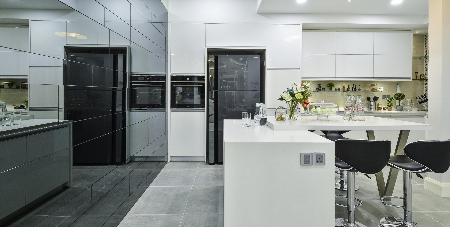Glossy cabinets in the kitchen are highly sought after, perhaps for the same reasons as lustrous minerals and polished baubles have been considered prized treasures since antiquity - a reflective surface imitates the world more accurately than any representational art form, while being nothing more than an otherwise meaningless object that has been polished smooth with effort, or a combination of time, pressure, and heat. If you happened across our analysis of materials commonly used in kitchen cabinets or countertops, and you have your heart set on updating your cooking space with glistening surfaces, you may be interested in taking a closer look at the advantages (and disadvantages) of reflective cabinets in the modern kitchen.
Smooth Surfaces
 Interior design by: Design Spirits
Interior design by: Design Spirits
While mirrored planes can be counted on to visually expand a space, most reflective surfaces are manufactured with a degree of smoothness that is measured in microns. This level of precision commonly entails an absence of texture in most materials, which can render a kitchen cold and aloof if large or seamless panes are applied without any discernible spacing to provide some semblance of texture. By applying reflective planes in a haphazard, brick-like configuration, the interior designer - Design Spirits provides this kitchen with both a visual expansion and a chaotic aesthetic element to contrast against the ordered lines of modern design.
Concealing Shade
 Interior design by: Hue Art Design
Interior design by: Hue Art Design
In addition to bearing little to no discernable texture, glossy cabinets will present greasy fingerprints more discernibly - in part, due to a characteristic imparting smooth planes with a “stickiness” (van der Waals forces), which attracts even the most microscopic of airborne particles and prominently displays light-disrupting dirt against a reflective surface. A slightly darker tint - as applied by Hue Art Design to the cabinets in this kitchen - will lessen the visual impact of dirt. Cleaning should be done periodically with a micro-fibre washcloth, to prevent scratches that could potentially add to the diffusion of light and result in slightly blurred reflections.
Intriguing Angles
Because mirrored surfaces reflect rather than absorb light, polished planes can be used to visually expand a space and provide unique perspectives that would not ordinarily be possible with matte surfaces. Designed by Zanotta, this kitchen utilises reflections to widen the scene and mystify the eye. Although partially obscured behind a projecting island, the polished doors on the lower cabinets present the entirety of the floor space to observers entering the kitchen - while the upper cabinets magnify the sunlight and warm yellow glows from the lighting fixtures.
Modern Circumstances
 Interior design by: Homlux Interior Furnishing
Interior design by: Homlux Interior Furnishing
The combination of space-expanding visual effects and typically narrow profiles make reflective planes one of the most indispensable ingredients of the modern urban home. Without the darkly-tinted reflected surfaces providing both visual expansion and contrast in this kitchen designed by Homlux Interior Furnishing, the narrow space may have otherwise appeared unbalanced with the abundance of stone, the extra height provided by the air-well, and the intense glow of the sun streaming in through the skylight.







Leave your comment